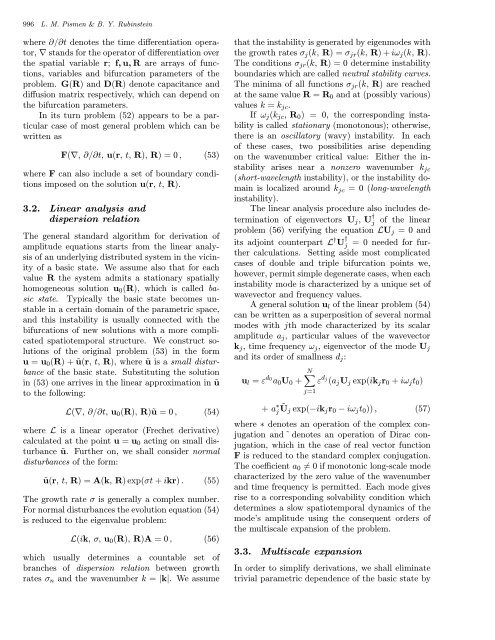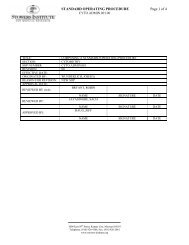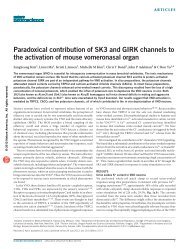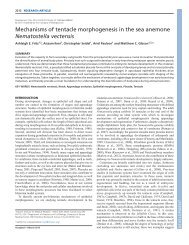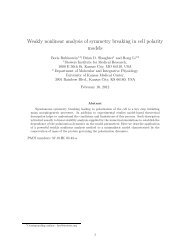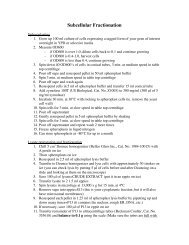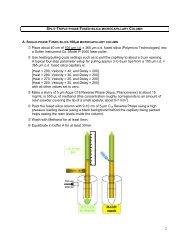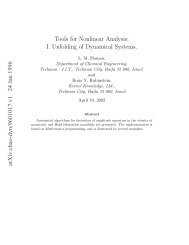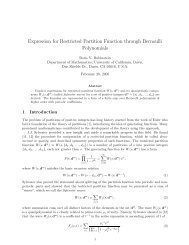Computer Tools for Bifurcation Analysis: General Approach with
Computer Tools for Bifurcation Analysis: General Approach with
Computer Tools for Bifurcation Analysis: General Approach with
Create successful ePaper yourself
Turn your PDF publications into a flip-book with our unique Google optimized e-Paper software.
996 L. M. Pismen & B. Y. Rubinstein<br />
where ∂/∂t denotes the time differentiation operator,<br />
∇ stands <strong>for</strong> the operator of differentiation over<br />
the spatial variable r; f, u, R are arrays of functions,<br />
variables and bifurcation parameters of the<br />
problem. G(R) andD(R) denote capacitance and<br />
diffusion matrix respectively, which can depend on<br />
the bifurcation parameters.<br />
In its turn problem (52) appears to be a particular<br />
case of most general problem which can be<br />
written as<br />
F(∇, ∂/∂t,u(r,t,R),R)=0, (53)<br />
where F can also include a set of boundary conditions<br />
imposed on the solution u(r, t,R).<br />
3.2. Linear analysis and<br />
dispersion relation<br />
The general standard algorithm <strong>for</strong> derivation of<br />
amplitude equations starts from the linear analysis<br />
of an underlying distributed system in the vicinity<br />
of a basic state. We assume also that <strong>for</strong> each<br />
value R the system admits a stationary spatially<br />
homogeneous solution u 0 (R), which is called basic<br />
state. Typically the basic state becomes unstable<br />
in a certain domain of the parametric space,<br />
and this instability is usually connected <strong>with</strong> the<br />
bifurcations of new solutions <strong>with</strong> a more complicated<br />
spatiotemporal structure. We construct solutions<br />
of the original problem (53) in the <strong>for</strong>m<br />
u = u 0 (R)+ũ(r,t,R), where ũ is a small disturbance<br />
of the basic state. Substituting the solution<br />
in (53) one arrives in the linear approximation in ũ<br />
to the following:<br />
L(∇, ∂/∂t,u 0 (R),R)ũ=0, (54)<br />
where L is a linear operator (Frechet derivative)<br />
calculated at the point u = u 0 acting on small disturbance<br />
ũ. Further on, we shall consider normal<br />
disturbances of the <strong>for</strong>m:<br />
ũ(r, t,R)=A(k,R)exp(σt + ikr) . (55)<br />
The growth rate σ is generally a complex number.<br />
For normal disturbances the evolution equation (54)<br />
is reduced to the eigenvalue problem:<br />
L(ik, σ,u 0 (R),R)A=0, (56)<br />
which usually determines a countable set of<br />
branches of dispersion relation between growth<br />
rates σ n and the wavenumber k = |k|. We assume<br />
that the instability is generated by eigenmodes <strong>with</strong><br />
the growth rates σ j (k, R) =σ jr (k, R)+iω j (k, R).<br />
The conditions σ jr (k, R) = 0 determine instability<br />
boundaries which are called neutral stability curves.<br />
The minima of all functions σ jr (k, R) are reached<br />
at the same value R = R 0 and at (possibly various)<br />
values k = k jc .<br />
If ω j (k jc , R 0 ) = 0, the corresponding instability<br />
is called stationary (monotonous); otherwise,<br />
there is an oscillatory (wavy) instability. In each<br />
of these cases, two possibilities arise depending<br />
on the wavenumber critical value: Either the instability<br />
arises near a nonzero wavenumber k jc<br />
(short-wavelength instability), or the instability domain<br />
is localized around k jc =0(long-wavelength<br />
instability).<br />
The linear analysis procedure also includes determination<br />
of eigenvectors U j , U † j of the linear<br />
problem (56) verifying the equation LU j =0and<br />
its adjoint counterpart L † U † j = 0 needed <strong>for</strong> further<br />
calculations. Setting aside most complicated<br />
cases of double and triple bifurcation points we,<br />
however, permit simple degenerate cases, when each<br />
instability mode is characterized by a unique set of<br />
wavevector and frequency values.<br />
A general solution u l of the linear problem (54)<br />
can be written as a superposition of several normal<br />
modes <strong>with</strong> jth mode characterized by its scalar<br />
amplitude a j , particular values of the wavevector<br />
k j , time frequency ω j , eigenvector of the mode U j<br />
anditsorderofsmallnessd j :<br />
N∑<br />
u l =ε d 0<br />
a 0 U 0 + ε d j<br />
(a j U j exp(ik j r 0 + iω j t 0 )<br />
j=1<br />
+ a ∗ j Ũj exp(−ik j r 0 − iω j t 0 )) , (57)<br />
where ∗ denotes an operation of the complex conjugation<br />
and ˜ denotes an operation of Dirac conjugation,<br />
which in the case of real vector function<br />
F is reduced to the standard complex conjugation.<br />
The coefficient a 0 ≠ 0 if monotonic long-scale mode<br />
characterized by the zero value of the wavenumber<br />
and time frequency is permitted. Each mode gives<br />
rise to a corresponding solvability condition which<br />
determines a slow spatiotemporal dynamics of the<br />
mode’s amplitude using the consequent orders of<br />
the multiscale expansion of the problem.<br />
3.3. Multiscale expansion<br />
In order to simplify derivations, we shall eliminate<br />
trivial parametric dependence of the basic state by


